The DirectX 12 Performance Preview: AMD, NVIDIA, & Star Swarm
by Ryan Smith on February 6, 2015 2:00 PM EST- Posted in
- GPUs
- AMD
- Microsoft
- NVIDIA
- DirectX 12
DirectX 12 vs. Mantle, Power Consumption
Although the bulk of our coverage today is going to be focused on DirectX 12 versus DirectX 11, we also wanted to take a moment to also stop and look at DirectX 12 and how it compares to AMD’s Mantle. Mantle offers an interesting point of contrast being that it has been in beta longer than DirectX 12, but also due to the fact that it’s an even lower level API than DirectX 12. Since Mantle only needs to work on AMD’s GPUs and can be tweaked for AMD’s architectures, it offers AMD the chance to exploit their GPUs in a few additional ways that a common, cross-vendor API like DirectX 12 cannot.
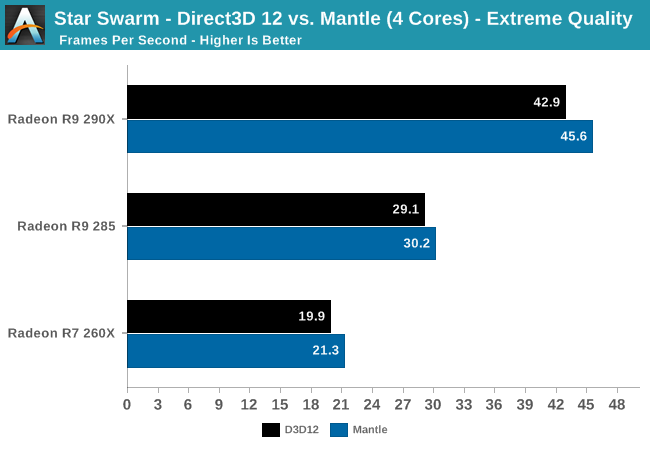
With 4 cores we find that AMD achieves better results with Mantle than DirectX 12 across the board. The gains are never very great – a few percent here and there – but they are consistent and just outside our window of variability for the Star Swarm benchmark. With such a small gain there are a number of factors that can possibly explain this outcome – better developed drivers, better developed application, further benefits of working with a known hardware platform – so we can’t credit any one factor. But it’s safe to say that at least in this one instance, at this time, Star Swarm’s Mantle rendering path produces even better results than its DirectX 12 path on AMD cards.
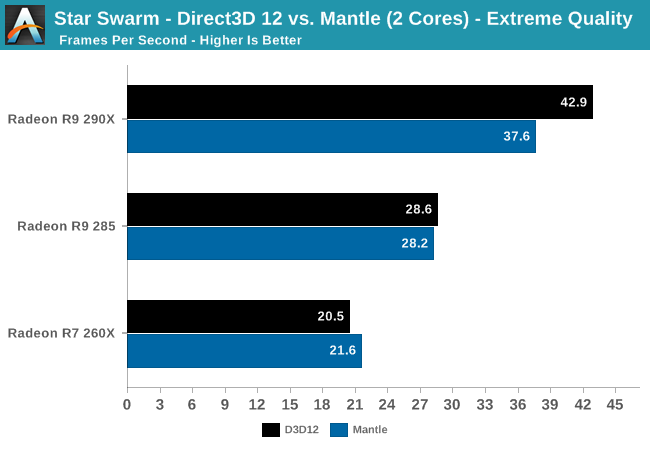
On the other hand, Mantle doesn’t seem to be able to accommodate a two-core situation as well, with the 290X seeing a small but distinct performance regression from switching to Mantle from DirectX 12. Though we didn’t have time to look at an AMD APU for this article, it would be interesting to see if this regression occurs on their 2M/4C parts as well as it does here; AMD is banking heavily on low-level APIs like Mantle to help level the CPU playing field with Intel, so if Mantle needs 4 CPU cores to fully spread its wings with faster cards, that might be a problem.

Diving deeper, we can see that part of the explanation for our Mantle performance regression may come from the batch submission process. DirectX 12 is unexpectedly well ahead of Mantle here, with batch submission taking on average a bit more than half as long as it does under Mantle. As batch submission times are highly correlated to CPU bottlenecking on Star Swarm, this would imply that DirectX 12 would bottleneck later than Mantle in this instance. That said, since we’re so strongly GPU-bound right now it’s not at all clear if either API would be CPU bottlenecked any time soon.
Update: Oxide Games has emailed us this evening with a bit more detail about what's going on under the hood, and why Mantle batch submission times are higher. When working with large numbers of very small batches, Star Swarm is capable of throwing enough work at the GPU such that the GPU's command processor becomes the bottleneck. For this reason the Mantle path includes an optimization routine for small batches (OptimizeSmallBatch=1), which trades GPU power for CPU power, doing a second pass on the batches in the CPU to combine some of them before submitting them to the GPU. This bypasses the command processor bottleneck, but it increases the amount of work the CPU needs to do (though note that in AMD's case, it's still several times faster than DX11).
This feature is enabled by default in our build, and by combining those small batches this is the likely reason that the Mantle path holds a slight performance edge over the DX12 path on our AMD cards. The tradeoff is that in a 2 core configuration, the extra CPU workload from the optimization pass is just enough to cause Star Swarm to start bottlenecking at the CPU again. For the time being this is a user-adjustable feature in Star Swarm, and Oxide notes that in any shipping game the small batch feature would likely be turned off by default on slower CPUs.
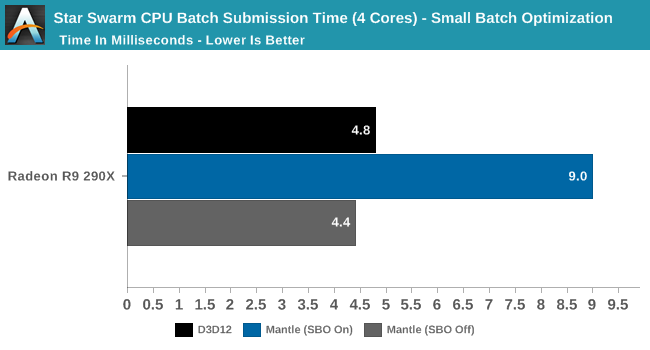
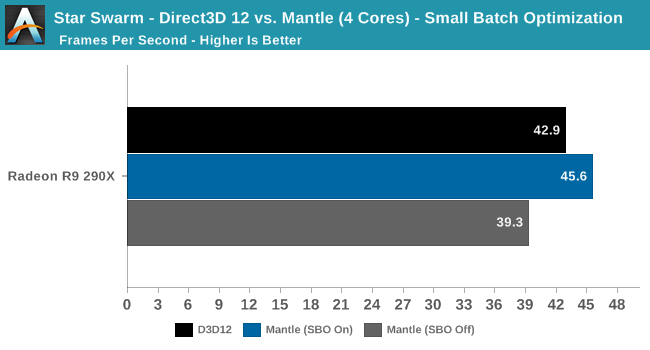
If we turn off the small batch optimization feature, what we find is that Mantle' s batch submission time drops nearly in half, to an average of 4.4ms. With the second pass removed, Mantle and DirectX 12 take roughly the same amount of time to submit batches in a single pass. However as Oxide noted, there is a performance hit; the Mantle rendering path's performance goes from being ahead of DirectX 12 to trailing it. So given sufficient CPU power to pay the price for batch optimization, it can have a signifcant impact (16%) on improving performance under Mantle.
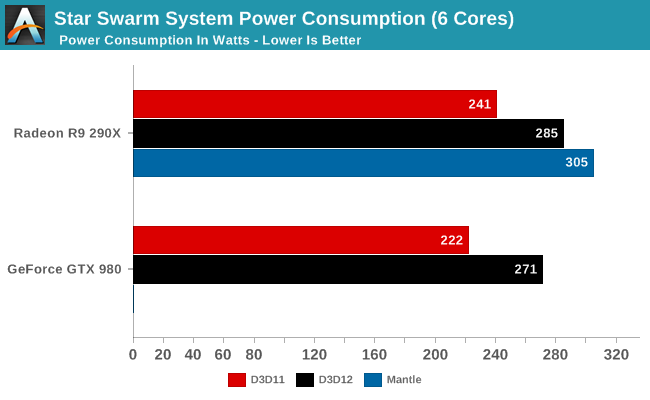
Finally, we wanted to take a quick look at power consumption among cards and APIs. To once again repeat what we said earlier, Star Swarm is an imperfect, non-deterministic benchmark, and coupled with the in-development status of DirectX 12 everything here is subject to change. However we thought this was interesting enough to include in our evaluation.
As expected, the increased throughput from DirectX 12 and Mantle drive up system power consumption. With the CPU no longer the bottleneck, the GPU never gets a chance to idle and video card power consumption ramps up to full load.










245 Comments
View All Comments
OrphanageExplosion - Sunday, February 8, 2015 - link
On a tiny minority of titles.bloodypulp - Sunday, February 8, 2015 - link
Battlefield 4Battlefield Hardline
Thief
Star Citizen
Plants vs. Zombies: Garden Warfare
Civilization: Beyond Earth
Dragon Age: Inquisition
Mirror's Edge 2
Sniper Elite 3
... and growing every day.
bloodypulp - Sunday, February 8, 2015 - link
Who needs to wait for DX12? Mantle is running great for me right now. :)sireangelus - Sunday, February 8, 2015 - link
would you do one quick test using an 8core fx?johnny_boy - Sunday, February 8, 2015 - link
Would have loved to see this, and some lower end CPUs even.editorsorgtfo - Sunday, February 8, 2015 - link
What about threaded CPUs ? for example 1 core 2 threads old pentium CPUs and 2 cores 4 threads i3 CPUs ? can you still count that them as 2 cores and 4 cores ?
I wanna ask this on the anandtech comment section but I don't have an account there XD
boe - Sunday, February 8, 2015 - link
What I care about are great graphics. It is a shame there is no Crytek 4 engine to show off what DX12 could do. MS should have hired the original crytek developers to create some showpiece game.Gigaplex - Monday, February 9, 2015 - link
The API won't really change what you can do compared to DX11 other than reduce some system requirements. The feature levels are what provides new eye candy, and this preview doesn't cover that aspect. Wait until it hits retail, you'll probably see some fancy tech demos.Thermalzeal - Sunday, February 8, 2015 - link
I have one big question to ask.Since Direct X12 is resulting in significant performance gains, what is the potential for these improvements to translate over to the Xbox One? While I'm sure the Xbox One already has some of these bare metal improvements, due to the focus of the device...is it possible that DX12 will make the Xbox One more powerful than the PS4?
Ryan Smith - Sunday, February 8, 2015 - link
"Since Direct X12 is resulting in significant performance gains, what is the potential for these improvements to translate over to the Xbox One?"Only Microsoft really knows the answer to that one. But I would be shocked beyond belief if the XB1's D3D 11.X API didn't already implement many of these optimizations. It is after all a fixed console, where low-level APIs have been a mainstay since day one.
"is it possible that DX12 will make the Xbox One more powerful than the PS4?"
In a word, no. The best case scenario for Microsoft is that Sony implements their own low-level API (if they haven't already) and we're back at square one. APIs can't make up for hardware differences when both parties have the means and influence to create what would be similar APIs.